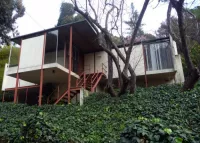Share what you know,
and discover more.
Share what you know,
and discover more.
Mar 09, 2022

-

- Charmaine Bantugan
Hale House
Craig Ellwood believed that his career as a designer began with the Hale House. Completed in 1951, it was the first building he designed after establishing his own practice in 1949. Bryant Hale, a teacher at Beverly Hills High School, fit the profile of many of Ellwood's early clients: educated, young professionals who had an appreciation for modern architecture and sufficient income to afford a small, custom-designed house. Ellwood received $900 for the design of the house and used the money to pay for a honeymoon with his wife, Gloria. The modular, cubic design of the house revealed – and celebrated – its steel-frame structure. Unlike traditional house styles, with windows and doors cut into the centers of walls, Ellwood's design uses only intersecting horizontal and vertical planes, some solid and some glass. To emphasize the drama and depth of the vertical and horizontal lines, Ellwood designed all walls to meet with slightly projecting edges or overhanging roofs. This created the shadow line, a dark contrast at every plane that became a signature element of Ellwood's future designs. The definition of edges created by shadows was also economical, as expensive trim could be removed from the design. Though the exterior of the house is glass, steel, and concrete, the interior features more natural materials and wood ceilings. The Hale House, along with Charles and Ray Eames Case Study House #8 and Raphael Soriano's Case Study House 1950, has been described by Reyner Banham as one of the three seminal postwar California houses. Photo courtesy Architectural Resources Group
Hale House
Craig Ellwood believed that his career as a designer began with the Hale House. Completed in 1951, it was the first building he designed after establishing his own practice in 1949. Bryant Hale, a teacher at Beverly Hills High School, fit the profile of many of Ellwood's early clients: educated, young professionals who had an appreciation for modern architecture and sufficient income to afford a small, custom-designed house. Ellwood received $900 for the design of the house and used the money to pay for a honeymoon with his wife, Gloria. The modular, cubic design of the house revealed – and celebrated – its steel-frame structure. Unlike traditional house styles, with windows and doors cut into the centers of walls, Ellwood's design uses only intersecting horizontal and vertical planes, some solid and some glass. To emphasize the drama and depth of the vertical and horizontal lines, Ellwood designed all walls to meet with slightly projecting edges or overhanging roofs. This created the shadow line, a dark contrast at every plane that became a signature element of Ellwood's future designs. The definition of edges created by shadows was also economical, as expensive trim could be removed from the design. Though the exterior of the house is glass, steel, and concrete, the interior features more natural materials and wood ceilings. The Hale House, along with Charles and Ray Eames Case Study House #8 and Raphael Soriano's Case Study House 1950, has been described by Reyner Banham as one of the three seminal postwar California houses. Photo courtesy Architectural Resources Group
Mar 09, 2022
Hale House
Craig Ellwood believed that his career as a designer began with the Hale House. Completed in 1951, it was the first building he designed after establishing his own practice in 1949. Bryant Hale, a teacher at Beverly Hills High School, fit the profile of many of Ellwood's early clients: educated, young professionals who had an appreciation for modern architecture and sufficient income to afford a small, custom-designed house. Ellwood received $900 for the design of the house and used the money to pay for a honeymoon with his wife, Gloria.The modular, cubic design of the house revealed – and celebrated – its steel-frame structure. Unlike traditional house styles, with windows and doors cut into the centers of walls, Ellwood's design uses only intersecting horizontal and vertical planes, some solid and some glass. To emphasize the drama and depth of the vertical and horizontal lines, Ellwood designed all walls to meet with slightly projecting edges or overhanging roofs. This created the shadow line, a dark contrast at every plane that became a signature element of Ellwood's future designs. The definition of edges created by shadows was also economical, as expensive trim could be removed from the design. Though the exterior of the house is glass, steel, and concrete, the interior features more natural materials and wood ceilings.
The Hale House, along with Charles and Ray Eames Case Study House #8 and Raphael Soriano's Case Study House 1950, has been described by Reyner Banham as one of the three seminal postwar California houses.
Photo courtesy Architectural Resources Group
Posted Date
Mar 08, 2022
Historical Record Date
Mar 09, 2022
Source Name
Los Angeles Conservancy
Source Website
Delete Story
Are you sure you want to delete this story?










